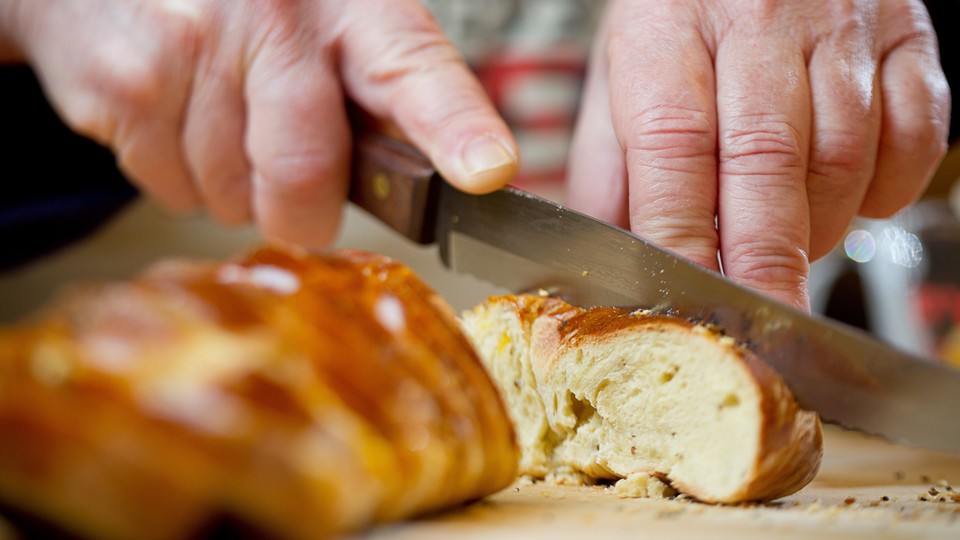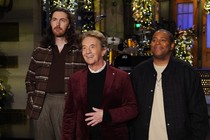The Women Who Caused a Revolution in Cooking
7 min read
This is an edition of the Books Briefing, our editors’ weekly guide to the best in books. Sign up for it here.
This week, Lily Meyer offered readers a beautiful ode to Judith Jones, the legendary publishing figure who essentially created the modern cookbook. It’s a review of Sara B. Franklin’s new biography of Jones, The Editor, but it’s also an explanation of how the writers Jones gathered around her, including, most famously, Julia Child, were at the center of a revolution in cooking. They wrote about the preparation of meals as an act of exploration. As Meyer put it, “They were a group of curious, courageous thinkers who, with Judith’s guidance, turned food into an intellectual project, writing books that, far from denigrating cooking as drudgery, presented it as a daily necessity that also, per Judith, ‘empowered you, that stimulated you.’”
I’ve been lucky to know one of Jones’s writers: Joan Nathan, the preeminent (though she’d laugh at the fussiness of the word) Jewish cookbook writer in America. Joan is the mother of a close friend, and I’ve luxuriated at her table many times over the years—the luxury being not just the meal but also the knowledge received, because Joan is a sociologist of Jewish food. No one knows more about, say, shakshuka or chicken soup, or, further afield, Georgian spanakit or Syrian keftes garaz. In the spirit of all of Jones’s authors, the culture and history of food is what matters to Joan, equally important as how many tablespoons of salt to add.
Joan herself has just published an excellent memoir, My Life in Recipes, which compiles dishes and stories from her decades of seeking out and elevating the varieties of Jewish food. It seemed like a good moment to speak with her about the books she loves.
First, here are four new stories from The Atlantic’s Books section:
- To have or not have children
- You’ll become a fan of these fierce, strange girls.
- The real “deep state”
- Go ahead and make fun of your friends.
This interview has been condensed and edited for clarity.
Gal Beckerman: You worked for 25 years with Judith Jones, who edited many of the legendary cookbook writers of the 20th century. Are there any that are particularly beloved by you?
Joan Nathan: So many! As soon as I moved to New York after living in Jerusalem in the early 1970s, I picked up the paperback of Claudia Roden’s A Book of Middle Eastern Food—that impressed me more than any other work. Here was someone who actually went to libraries to find the original versions of recipes in order to create her own. After that, I started using my now-stained copies of Julia Child’s Mastering the Art of French Cooking, Volumes 1 and 2. Throughout my life, I have always checked first with Julia as a gold standard of recipe writing and compared her work with others’. After Julia, it was Madhur Jaffrey’s An Invitation to Indian Cooking that taught me how to cook Indian dishes, then Edna Lewis, who won my heart in 1976, and Marcella Hazan, with her Classic Italian Cook Book. In those years, I was glued to every word that Craig Claiborne wrote, so I am sure that it was his recommendations in The New York Times that encouraged me.
Beckerman: Your own memoir beautifully melds stories from your life with recipes, a great hybrid form. Are there other books that do this that you looked to as models?
Nathan: It’s funny. I never thought about a model for My Life in Recipes. Lexy Bloom, my editor at Knopf, and I thought of the book as a hybrid, but now that you ask, I used M. F. K. Fisher’s work to carry me away to another time and place, as well as Elizabeth David’s delicious evocations of the south of France in French Provincial Cooking, transporting the reader with her as she explored new foods and places. For thinking about Jewish food, I especially enjoyed the work of Anzia Yezierska, her Bread Givers and Hungry Hearts, where the author drew me into the immigrant eating experience on the Lower East Side of New York.
Beckerman: Are there any other memoirs, or even novels, you love that do a good job depicting food or cooking?
Nathan: I just finished reading The Rye Bread Marriage, by Michaele Weissman, a food memoir melding the history of rye bread, the complexities of an immigrant marriage, and fabulous food writing. Ruth Reichl’s The Paris Novel, into which Ruth wove her experiences visiting the best chefs and recipes in France, happily carried me back to another time and place in my own life. Whenever I read a novel, I look for good descriptions of food, but it is the story that carries me away. More than any other work, Marcel Proust’s Remembrance of Things Past, which I just recently reread, is more poetic than anything in describing asparagus and so many foods that we eat. I first read it when I was in college, doing my master’s thesis on the image of Esther in the work of Proust.
Beckerman: And finally, do you have an all-time-favorite cookbook (or two or three)—something you’ve thrust into other people’s arms over the years?
Nathan: Besides all of my own, which I must admit I dearly love, a few stand out. Of course, my many copies of editions of The Settlement Cook Book of German Jewish and non-Jewish recipes are important, but a personal favorite is The Community Cook Book, put out by the Woonsocket Hebrew Ladies’ Aid and Sisterhood of Congregation B’Nai Israel in Rhode Island, one of the first postwar synagogue cookbooks. During World War II, when the men were away at war, the women tested and retested recipes that include examples of early Eastern European dishes like povidle, plum butter, and cherry pirishkes, recipes that are mostly forgotten from what is now modern Ukraine. And, very occasionally, I will show visitors some of the many handwritten cookbooks handed down to me from my aunts, grandmother, and great-grandmother.

The Woman Who Made America Take Cookbooks Seriously
By Lily Meyer
Judith Jones edited culinary greats such as Julia Child and Edna Lewis—and identified the pleasure at the core of traditional “women’s work.”
Read the full article.
What to Read
The Taste of Country Cooking, by Edna Lewis
Lewis’s exemplary southern cookbook is interspersed with essays on growing up in a farming community in Virginia; many of the recipes in the book unspool from these memories. Lewis, who worked as a chef in New York City as well as in North and South Carolina, writes with great sensual and emotional detail about growing up close to the land. Of springtime, she writes, “The quiet beauty in rebirth there was so enchanting it caused us to stand still in silence and absorb all we heard and saw. The palest liverwort, the elegant pink lady’s-slipper displayed against the velvety green path of moss leading endlessly through the woods.” Her book was ahead of its time in so many ways: It is a farm-to-table manifesto, a food memoir published decades before Ruth Reichl popularized the form, and an early, refined version of the cookbook-with-essays we’re now seeing from contemporary authors such as Eric Kim and Reem Assil. The recipes—ham biscuits, new cabbage with scallions, potted stuffed squab—are as alluring as the prose. — Marian Bull
From our list: Eight cookbooks work reading cover to cover
Out Next Week
📚 Fire Exit, by Morgan Talty
📚 The Fall of Roe: The Rise of a New America, by Elizabeth Dias and Lisa Lerer
📚 The Other Olympians: Fascism, Queerness, and the Making of Modern Sports, by Michael Waters
Your Weekend Read

What’s Really Epic About Furiosa
By Shirley Li
Even as a little girl, Furiosa understood the value of staying hidden in the wasteland of postapocalyptic Earth, where resources are scarce, war is everlasting, and strangers are immediately treated as threats. But keeping out of sight is not the easiest task in the Mad Max films. The director George Miller’s dystopian setting conceals little; his bleak hellscapes provide the perfect stage for thunderous exhibitionism, the kind that yields characters such as the Doof Warrior, who shreds a flame-throwing electric guitar to lead militias into battle. For most humans in this world, surviving means roaring through life with ruthless ferocity on armor-plated vehicles. The madder you are, the better off you’ll be.
Read the full article.
When you buy a book using a link in this newsletter, we receive a commission. Thank you for supporting The Atlantic.
Explore all of our newsletters.



